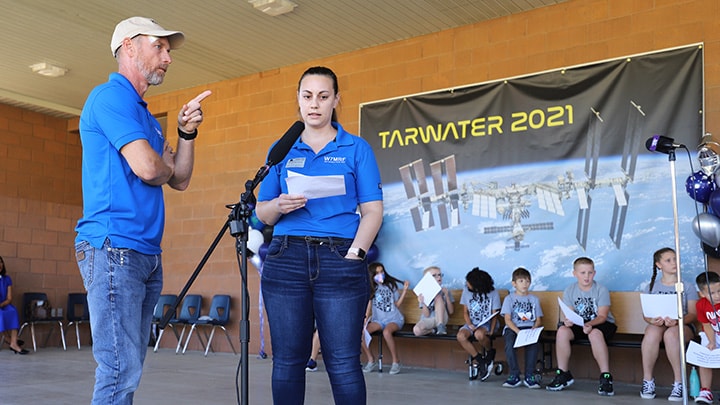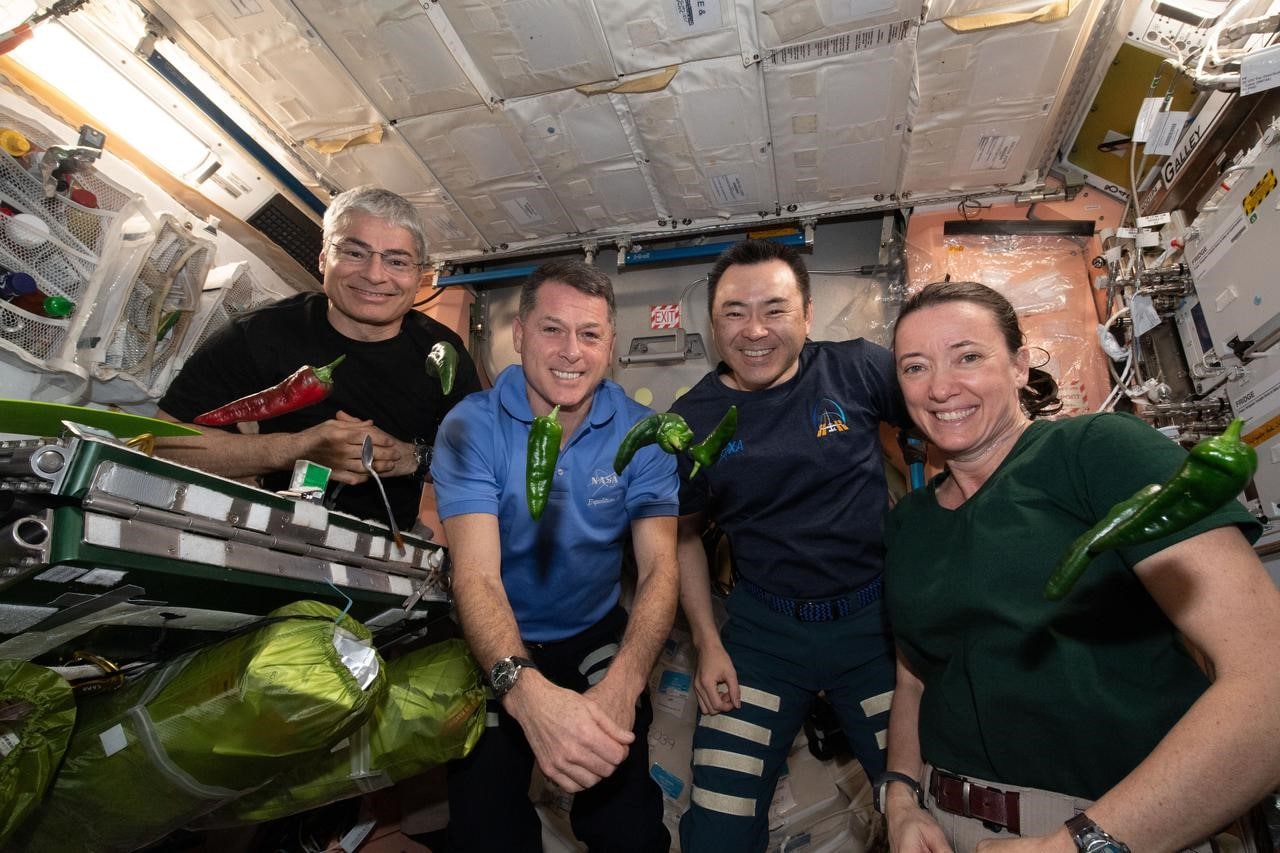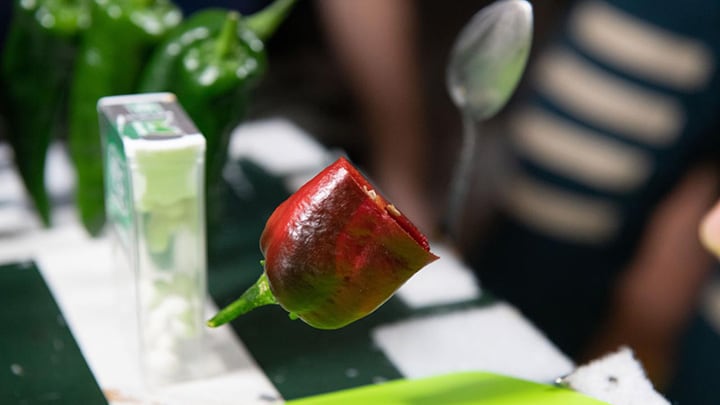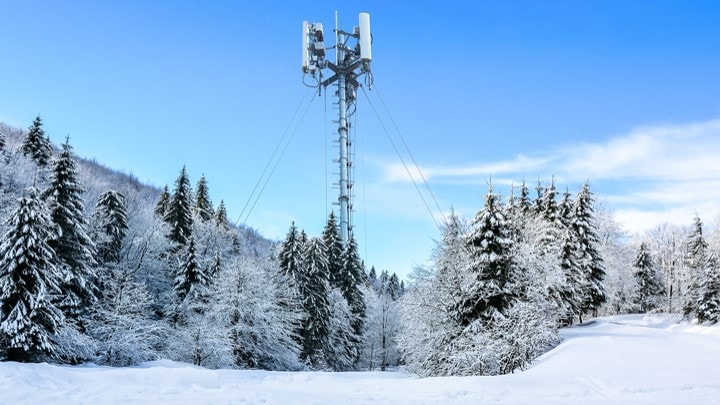At
Tarwater Elementary School
in Chandler, Arizona, students recently spoke with astronauts on the
International Space Station via Amateur Radio. This activity is part of the
amateur radio on the International Space Station (ARISS) program, promoting learning opportunities as part of the STEM (Science, Technology,
Education, and Math) initiative.
ARISS is managed by an international working group, including several
countries in Europe, as well as Japan, Canada and the United States.
Volunteers run the organization from the national amateur radio organizations
and the international radio amateur satellite corporation (AMSAT)
organizations from each country. They provide the equipment and operational
support to enable direct communication between crew on the ISS and students.
Since ARISS is international in scope, the team coordinates locally with their
respective space agency.
End-to-end solutions for diverse networks and architectures enable
connectivity in space. Learn more about our
radio frequency solutions.
Selection Process
The ARISS-US program opens proposal windows for applicants from the United
States twice a year to schedule radio contacts with the ISS, 6-12 months in
advance. Tarwater Elementary School is only one of seven schools in the US
selected to contact the ISS this year. It was an infusion of amazing students,
staff, administration and parents who made this experience of a lifetime
possible.
The school’s STEM lab opened in 2017 and has become a hub for all grade levels
to experience hands-on learning. The school has prepared for the ARISS contact
by incorporating various NASA and amateur radio content into their STEM lab
activities. These activities include science experiments to investigate and
explore the nature and properties of radio waves. The questions students
planned to ask astronauts on the ISS were generated based upon their yearlong
learning and research of space and the ISS.
Amateur Radio Coordination
NXP’s Amateur Radio Club based in Chandler AZ coordinated the ISS contact
event. The amateur radio ground station uses the radio callsign W7MRF and the
ISS used NA1SS. It is operated by two NXP engineers, Lionel Mongin F1JRD/KW7MM
and Jim Davies K7JFD. Both have been ham enthusiasts and active participants
in amateur radio since the early 1990s. Jim Davies, President of W7MRF,
explained that the ground station uses RF transistors designed in Chandler as
part of the amplifier.
 NXP engineer Lionel Mongin setting up the amateur radio ground station
NXP engineer Lionel Mongin setting up the amateur radio ground station
"What ARISS is doing for students by introducing them to wireless technology
and space exploration is inspiring. It is an honor that Tarwater Elementary
School was selected to give an opportunity for all of us to learn about the
world beyond."
Lionel Mongin, Applications Engineer Manager, Radio Power, NXP
The equipment comprises a VHF radio driving a 2 meter amplifier. Software is
used to track the space station and adjust for Doppler effects. To explain,
when there is relative motion between the wave source and the observer, there
are changes in the observed frequency of a wave, which needs precise
adjustment – especially considering that the ISS orbits Earth at an average
speed of 17,500 mph and roughly 250 miles above Earth. For calculating when
the ISS passes overhead, the software provided their exact geographic location
and coordinates.
 The beam antenna on the roof of a converted news van rotates to ensure
contact
The beam antenna on the roof of a converted news van rotates to ensure
contact
This information is then fed into a seven element, cross-polarized Yagi
antenna located on the roof of a repurposed news van. It is controlled with
dual rotators that adjust for both azimuth and elevation. Azimuth tells what
direction to face, and elevation is how high up in the sky to look. Together,
they ensure that the ground station is in constant contact with the ISS. In
addition to all this equipment, the team has an independent battery-powered
backup station running an ICOM 910H satellite transceiver and a small
4-element Yagi.
"We are pleased that some of our RF transistors that are designed right here
in Arizona were used in our equipment. They made up part of the amplifier
that the students used to talk with Astronaut Shane Kimbrough on the
International Space Station."
Jim Davies, Senior Applications Engineer, Radio Power, NXP
Almost There
In the days leading up to radio contact, the students were tracking and
researching the ISS and the astronauts on board. Just before the scheduled
radio contact, the NXP Amateur Radio Club was invited to speak at the school
to give various demonstrations on the real-world application of radio waves.
Students learned how a wave’s amplitude and energy are related, calculated
wave speed, explored how waves change direction when they travel from one
medium to another, compared various types of electromagnetic waves and
distinguished between AM and FM modulation.
 Whiskey Seven Mike Radio Foxtrot (W7MRF) calling for a scheduled school
contact
Whiskey Seven Mike Radio Foxtrot (W7MRF) calling for a scheduled school
contact
Earth Calling ISS…
With a downlink frequency of 145.800 MHz, the NXP Amateur Radio Club connected
the students with astronaut Shane Kimbrough (KE5HOD). The students had a
host of questions to ask Kimbrough, with the entire school watching in the auditorium.
Astronaut Shane Kimbrough speaks with students at Tarwater Elementary
School
The first student to step up to the microphone was 6th grader Margaux. She
asked: What kind of research are you doing on the Space Station?”
Speaking via the radio aboard the ISS, Astronaut Shane Kimbrough came over the
speaker loud and clear: “We do all kinds of research up here, from plant
research to medical research to fluid research and material research. All
different types of sciences we get to do up here.”
Next up, wearing a NASA T-shirt, Clark from the first grade asked a
thought-provoking question: “Are your dreams different in space compared to
dreams on Earth?”
“Very good question,” said Kimbrough. “I haven’t had any different types of
dreams up here. I think some of my colleagues may answer this differently,
but, for me, my dreams here are very much like I have back on Earth.”
Hayden, from the 5th grade, then asked Kimbrough:” What is the most
interesting or challenging thing that you have done on the ISS?”
“We’ve had a lot of things to do up here in the last six months that we’ve
been on board,” he replied. “I think the hardest and most challenging things
that myself and Thomas Pesquet, the French astronaut, got to do was a few
spacewalks to install brand new solar arrays on the outside of the space
station. It was really challenging – mentally and physically.”
An emotive question from Brody followed: “What do you miss most about home?”
“Brody, of course, I miss my family, but things you probably want to know are
other things,” joked Kimbrough. “I miss feeling the weather and feeling the
wind, and smelling fresh-cut grass and things like that. I also miss a
shower!”
Asking a science question, Jules, from 2nd grade: “Where does the air you
breathe come from?”
“Jules, we have something similar to like an air conditioning system in your
school or in a building,” explained Kimbrough. “We have a great system on the
space station. If we need extra oxygen, we have tanks on the outside of the
space station that have pipes to pipe it into the inside. We have a great
system here to make sure we have enough air to breathe.”
What to Pack for a Space Mission
Delving into Kimbrough’s personal life, Bryson asked: “What type of personal
items do you bring with you?”
“Well, I brought a lot of things,” said Kimbrough. “We’re lucky enough to
bring some things. Things I usually bring are pictures of my family and some
jerseys or T-shirts from my colleges, universities and high schools that I
went to – things like that. And, if you have anything special from maybe your
family members or friends, you bring a few of those things as well.”
Representing the school’s Kindergarten, Easton asked a food-related question:
”Which do you like more, regular ice cream or space ice cream?”
“Great question,” replied Kimbrough. “There’s no contest there, regular ice
cream for sure. We actually got sent some regular ice cream a few months ago
on one of the cargo vehicles, so we got to eat it in space.”
Asking another science-related question was Elyse, from 5th grade: “How do
light and sound travel in space?”
“Well, Elyse, I can only answer that from my experience here on the
International Space Station and, on board here, it travels just like it does
back on Earth – the light and the sound. It is different when you’re outside
in the vacuum of space but I’m not smart enough to be able to answer that
question.”
David from the 4th grade asked: “How do you know what day it is on the space
station?”
“We run on Julian calendar dates, so today is day 300 of the year 2021. I
don’t know if you knew that, but we run on those kinds of days. Today’s 300,
tomorrow’s 301 and, at the end of the year, December 31, is 365. Then we start
over with one on January 1. We also know it’s October 27, but, in general, our
schedules are driven by the Julian dates.”
Brooklyn from the school’s 6th grade asked an interesting question: “How does
it feel when you come down from space? Do you feel dizzy?”
“Excellent point there, Brooklyn,” he replies. “Most of us do feel very dizzy
because our sense of balance, which is in our inner ear, has been floating
around for six months. So, when we get back to gravity, it’s trying to figure
out where it is, and it usually takes a couple of days for us to regain our
balance.”
Margaux’s second question was: “What happens if you encounter space junk or
meteoroids? What are the procedures?”
“Thank goodness that we don’t have any of the big collisions up here, but
sometimes we get close, and when that happens, we have great people in mission
control teams around the world that can help us. If we see it early enough,
they can actually move the space station out of the way, so we don’t hit the
object. If it’s kind of late in the game, then we will just get in our
spacecraft and kind of hunker down there in case something hits the space
station. Then we can depart if we have to – then again, fortunately, none of
that has ever happened. We get micrometeoroids that hit the space station
quite often, and those are really, really tiny things that don’t puncture the
space station, thank goodness.”
Plants Growing in Space
 Hatch chili peppers growing nicely on the International Space Station
Hatch chili peppers growing nicely on the International Space Station
Clark’s second question was: “Do plants grow taller than usual in
microgravity?”
“We don’t get to grow a whole lot of things, but I’ve been fortunate on my
last two missions to grow lettuce. Right now, we’re growing Hatch chili
peppers, and they haven’t grown any taller than normal, but they do grow
really nicely up here – so we’re looking forward to harvesting these peppers
next week and getting a chance to eat them.
 The crew on the ISS tasting their harvested Hatch chili peppers
The crew on the ISS tasting their harvested Hatch chili peppers
Hayden’s second question was: “How often do you have to fix things at the
International Space Station?”
“We fix things quite often actually; I would say daily at least one of the
crew members is working on fixing something. That’s because this incredible
International Space Station we live on has been up here for over 20 years now,
so things break. Whether it’s electronic or plumbing, it’s always something
different, but we’re up here with the help of the mission control teams to fix
those things.”
Brody’s second question: ”What is the hardest part of your job?”
“For me, Brody, it’s just being away from my family and friends for really
long periods of time. So, as I said earlier, we’ve been up here six months; we
have another week or two to go, then we’ll get a chance to get back home to
our family and friends.”
Since the interview, Kimbrough has returned to terra firma safely. NXP offers
a huge round of applause to everyone involved in this event. Thank you NXP
engineers, Lionel Mongin and Jim Davies for coordinating the contact and being
great STEM ambassadors to Tarwater Elementary School.
"I really appreciate our NXP engineers Jim and Lionel for making this ISS
radio contact so successful. It was great to see radio equipment that is
powered by our NXP silicon. The event was very well coordinated with the
students and Astronaut Shane Kimbrough."
Paul Hart, Executive Vice President and General Manager, Radio Power,
NXP










